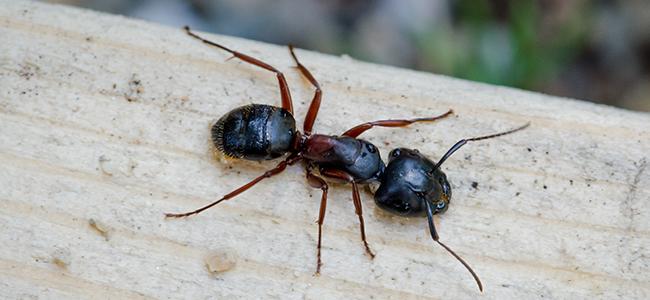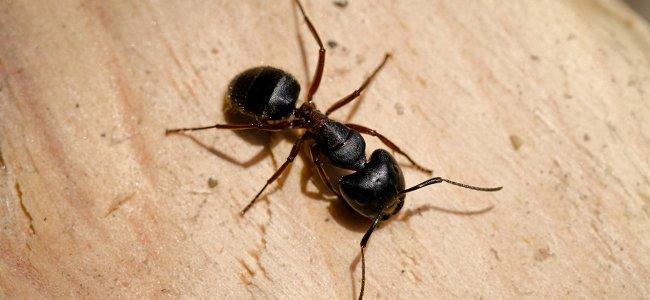
How to Get Rid of Carpenter Ants on Your Maryland Property
11/05/2021
Carpenter ants on your Maryland property can be a major issue when it comes to your home’s structural support and food storage. Understanding...
READ MORE >

Are you seeing ants in your home? Are you thinking, "Hold on a second, don't ants go into hibernation in the winter?" We understand. It seems like ants go into hibernation in the winter because they usually disappear in the winter until the return of spring. But they don't. Ants don't actually hibernate, but instead enter into a low-energy state called diapause. They will enter this state if temperatures drop too low or if food resources become scarce. The big difference between hibernation and diapause is that an animal in diapause will become active again when the unfavorable conditions have passed. Or they may not enter into diapause at all and remain active through winter if unfavorable conditions never occur. This principle is why carpenter ants are still crawling around in DC.
Carpenter ants are unique among ants because they chew galleries in wood to create a safe location to establish their nests. And when they create these galleries inside the wood of our homes, they can find favorable conditions all year long and remain active through the winter. This is bad news for any home that has been infested with carpenter ants because, the longer these ants remain active in your home, the more damage they can do. And, over time, those damages can become extensive.
There are many ways to determine whether or not your DC home has been infested by carpenter ants. The first and most obvious sign is the appearance of large black ants crawling around inside your home. You might see one on your kitchen counter. You might find one on a pantry shelf. But no matter where you find them, spotting even one carpenter ant inside your home is an indication of an infestation, so don’t brush off this sign.
Another warning sign that should be obvious, but is often overlooked is the appearance of flying ants on our window panes. When flying ants start crawling around on their window panes and interior window ledges, many homeowners suck them up with a vacuum and call it a day because they think those flying ants flew in from the outside of their home. But it is important to understand that carpenter ants are attracted to light and don't prefer the dimmer interior lights of your home to the bright, sunny yard around your home. So the appearance of flying carpenter ants inside a home is usually a sign of a current infestation established in the home rather than an accidental invasion.
When flying ants appear on the outside of a home, this can be a sign of a current infestation as well. In the spring, carpenter ants reproductives emerge from their mature nests to mate and establish new nests. There swarms typically only last for about 30 minutes and they don't travel far from their old nests. So if you find flying ants around your home or big, black ants crawling on the outside of your home, it is definitely time to call a professional.
Since these flying ant swarms don't last long, you may not see those winged ants at all, you may only see the wings they leave behind. Soon after swarming, these reproductives shed their wings. You may find them scattered on the ground, especially near sources of wood. If only a few ants came into your yard from your neighbor's yard, you may not see any of these wings at all. When looking for these wings, a good place to check is in any spider webs on your property. These are nature's sticky traps. If you find wings or whole carpenter ants in stuck in these webs, or anywhere else on your property for that matter, you should consider investing in an inspection from a pest control professional.
You would think that wood damage would be the first sign to look for when determining whether or not your home has been invaded by carpenter ants. This might be the case if these wood-destroying pests fed on wood. But these ants don't actually consume wood; they just tunnel into it in order to establish their nests inside. So the most damage you're likely to see is the spots where they’ve chewed their way in. Look for these holes at the bottom of door frames and your window frames. These are common spots that carpenter ants chew their way into our homes as these areas usually have high moisture levels. These damaging pests are attracted to areas of damp, water-damaged wood.
When carpenter ants tunnel through wood, they have to do something with the sawdust they create since they don’t eat it. To get rid of the sawdust in their tunnels, these ants push it out tiny kick-out holes. If these kick-out holes are created in visible locations in your home, you may be able to use them to detect an infestation in your home. But the frass generated by carpenter ants is going to be a lot more noticeable than those kick-out holes. Look for this sawdust-like frass clinging to the wall under these holes, piled on the floor, pouring out of gaps, or stuck to beams.
However, if this frass is pushed out into the voids of your home where it can't be seen or into a location that is hard to access such as the crawl space under your home, it can remain undetected and allow carpenter ants to continue secretly damaging your home.
When you detect carpenter ants in your DC home, the team at American Pest is standing by to assist you with industry-leading carpenter ant control. Get started by scheduling a free estimate!

11/05/2021
Carpenter ants on your Maryland property can be a major issue when it comes to your home’s structural support and food storage. Understanding...
READ MORE >

08/06/2021
If tapping and gnawing sounds in your walls aren’t suspect enough, the presence of sagging walls and hollow furniture will be a dead giveaway...
READ MORE >

05/08/2020
One of the greatest challenges with preventing carpenter ant damage is public awareness. People know far too little about how carpenter ants infest...
READ MORE >

Protect your home and family from nuisance and potentially damaging pests with a Preferred Care home pest control plan. Starting at $49/month

Don't let the bed bugs bite a second longer. Contact American Pest for the most comprehensive bed bug control in the industry. Learn More

Our certified rodent control pros will put an end to your frustration by getting rid of rats and mice inside your home. Learn More

Say goodbye to wood-destroying termites in your home when you contact American Pest for expert termite control. Learn More

Trust American Pest to deliver professional backyard tick control services that are guaranteed to get results. Learn More

Don't spend the warm-weather season indoors, find out how American Pest's professional treatments get rid of mosquitoes. Learn More
Fill out the form and recieve feedback in less than 5 minutes. For immediate service please call.